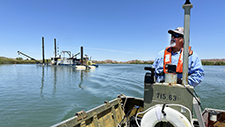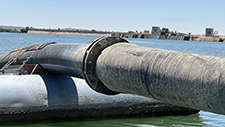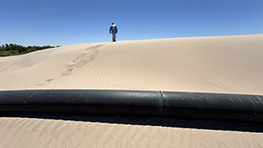 Reclamation Foreman Damon Yabo returns to shore after visiting the dredge. The sediment removal effort is needed to keep water flowing through the Imperial Dam to water users in Arizona and California. (📸 by Tim Dewar)
Reclamation Foreman Damon Yabo returns to shore after visiting the dredge. The sediment removal effort is needed to keep water flowing through the Imperial Dam to water users in Arizona and California. (📸 by Tim Dewar)
After flowing through the Imperial Dam into the All-American and Gila Gravity Main canals, Colorado River water irrigates more than 500,000 acres of farmland and serves homes and businesses in southern Arizona and California’s Imperial and Coachella valleys.
To keep that water flowing, the Bureau of Reclamation is removing 54 million cubic feet of sediment from a 70-acre area upstream of the Imperial Dam. The operation is expected to restore about 1,250 acre-feet of water storage space in the reservoir above the dam. Reclamation’s Yuma Area Office Deputy Area Manager Owen Fulsome said the recovered storage was not the driving force behind the project but is an added benefit.
“If we didn’t remove it, sediment would build up near the entrance to the canals and would prevent water from flowing through the Imperial Dam,” explained Fulsome.

Dredging is the most effective and cost-efficient way to address the sediment problem above Imperial Dam, according to Fulsome.
Reclamation dredges the river about every 10 years. The amount of sediment that accumulates in that time depends on annual rain totals and heavy storm flows. With stormwater flowing from many washes and streams into 276 miles of Colorado River under the Yuma Area Office’s jurisdiction, this year’s project has a large quantity of material to remove.
To help slow the accumulation and reduce the need for more frequent dredging, Reclamation takes preventive measures including removing sandbars in key upstream areas, installing sediment control structures, and repairing eroded riverbanks.
Once collected by the dredge, the material is pumped through a hydraulic pipeline to Reclamation land approximately a mile below the dam. Much of the water used to move the material soaks into the ground, but some filters through a settling basin and is returned to the Colorado River.
The sediment removed from the river isn’t just placed on Reclamation land and forgotten. Some of this material can be used to others’ benefit.

“In years past,” Fulsome explained, “we have given the dredged material to other agencies, counties and municipalities to replenish beach areas or to help build up low-lying areas for future restoration work.”
Fulsome estimates the dredging effort will cost about $10.2 million, which includes nearly $1.2 million funded in fiscal year 2024 by the Bipartisan Infrastructure Law. He said the project, that began in March of 2021, is projected to end in late 2025.

